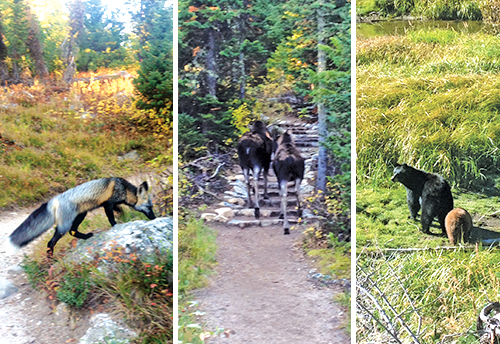
Planet Jackson Hole – With every excursion this fall, I’ve encountered some sort of wildlife between my front door and the woods. Though woods walking may be mellow, it seems important to consider the various creature meetings that could happen unexpectedly. Take a walk into Grand Teton National Park and you may stumble upon a random sign on the trail that reads, “Bear attack — Are you prepared?” I can understand why visitors may be scared. If I saw a sign planted in the middle of the ocean that read: “Shark attack — Are you prepared?” I would definitely contemplate swimming to the shore. Viewing the park sign got me thinking about what exactly you are supposed to do when running into animals. The circuitous answer is — it depends on what hairy animal that may come your way and even then, it depends on the species.
Bears
Bears are the most common animals that people fear as they tromp in the woods. Common preventative items include bear bells and bear spray. But beware, no statistical evidence has shown that bear bells are effective at keeping bears away. These cheap ringers may be more effective at making other humans avoid you at all costs. More effective techniques include talking or singing to make bears aware of human presence. I suppose it would depend on who the singer is, but this tidbit of knowledge may be useful to fellow outdoor enthusiasts.
If a bear attacks, you must first decide what kind of bear it is. Grizzlies, known for their hump, dished face and tiny round ears, are likely to simply charge you for territorial purposes to protect their cubs or carcasses they are feeding on. That being said, I do know a stringy old cowboy who got attacked twice in a year by a grizzly. The first time, the attack occurred amongst windy willows and the alleged predator was an old, hungry bear. The fellow played dead after being bit and survived to tell the tale. A few months later, camped under a tarp, the man dreamt a pitchfork was in his butt. In reality a bear was biting his rear end, but lucky for him, his dog scared the creature away.
Black bears, known for their long noses and prominent ears, may be smaller but are nothing to mess with. Most of their attacks are predatory, so if a black bear charges you, prepare to fight back vigorously, as they are likely more interested in dinner than a fight. Bear spray has proven to be the most effective way to defend oneself from bears.
Moose
Moose injure more people per year than bears and should be taken seriously. Bull moose seem to be especially aggressive this time of year as are cows with calves. Oftentimes, they can be found munching on thick willows in areas that the hiker cannot see. By the time you can spot them, they’re already angry and huffing. If their hair spikes up on the top of their heads and lips are smacking, prepare an exit strategy. Give them space and back away. If they start chasing after you, weave in and out of trees, as they have poor vision and a terrible turning radius. There is nothing that suggests bear spray is effective with moose but I have heard of it being used and wouldn’t hesitate to use it myself.
Mountain lions
Mountain lions kill about one person a year. There is some argument as to whether running from them or freezing up is more effective when considering your chance of survival. The most effective technique for mountain lion attacks has been hitting the lion with a stick. These elusive creatures do not care to be seen, so if one were seen up close and personal, it wouldn’t hurt to prepare to be on the defensive.
I’ve covered many of the popular four-legged beasts in this area, but keep in mind, people have died from beaver, bison and deer attacks. Yes, a beaver bit a fisherman’s femoral artery a couple years ago causing him to bleed out. Although this happened in Lithuania, life can be filled with unexpected events. Common sense and space when encountering animals may just keep the observer a bit safer. It can never hurt to be prepared, but just remember that pet attacks account for about 30 deaths per year in the United States while cows account for about 20. I have never seen a sign warning me of these creatures in the middle of cow pastures or dog parks, but continue to keep statistics in mind in your wild excursions. PJH
